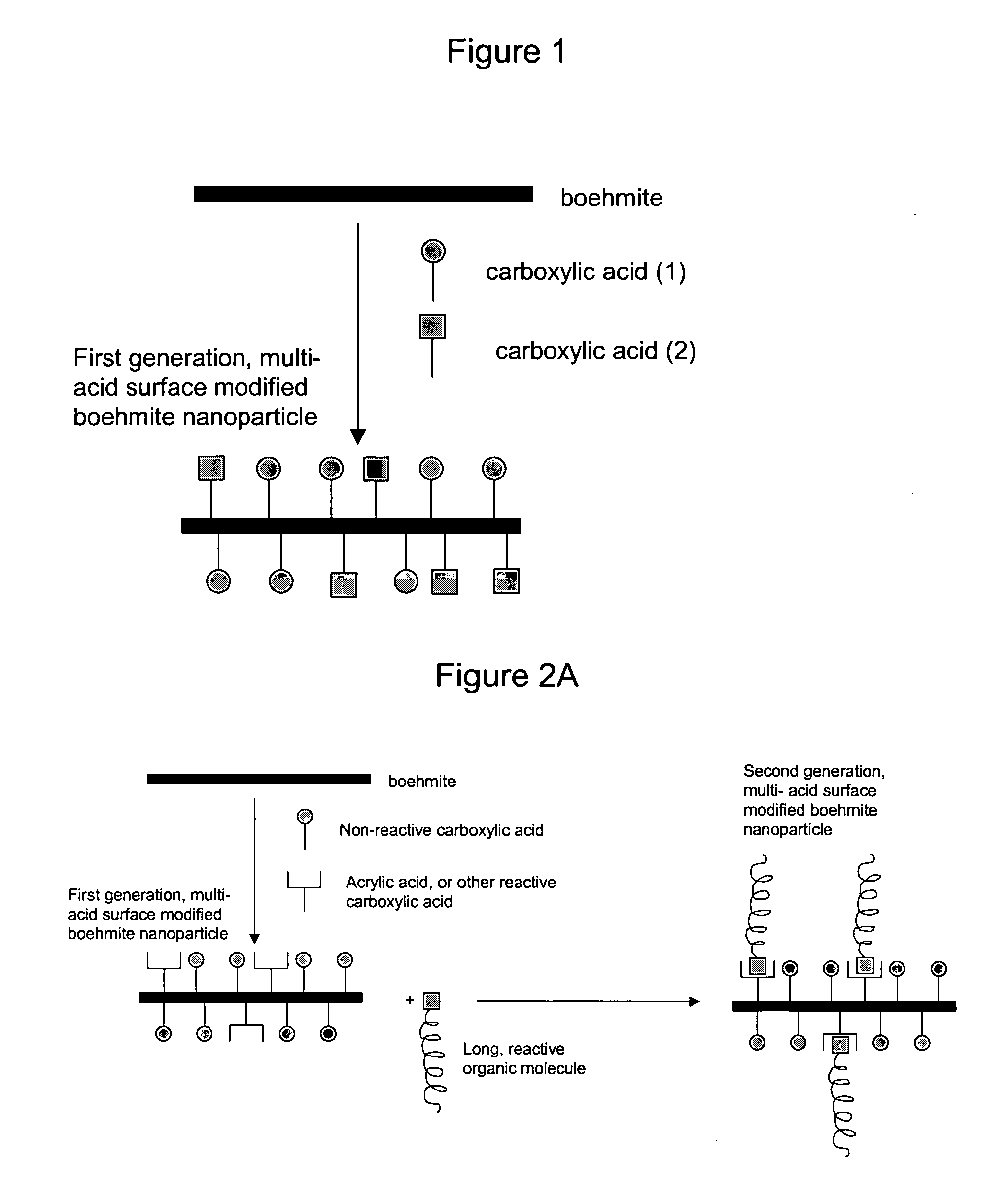Nanoparticles modified with multiple organic acids
a technology of organic acids and nanoparticles, applied in the direction of group 3/13 element organic compounds, natural mineral layered products, synthetic resin layered products, etc., can solve the problems of high oil absorption, nano-sized filler materials are substantially more difficult to process, and patents do not specifically address the technical challenges of working with nanoparticle materials
- Summary
- Abstract
- Description
- Claims
- Application Information
AI Technical Summary
Benefits of technology
Problems solved by technology
Method used
Image
Examples
example 1a
[0099]Preparation of Methacrylic Acid Modified Boehmite Nanoparticle (Aluminum to Acid Mole Ratio 6:1)
[0100]This example illustrates the preparation of methacrylic acid modified-pseudoboehmite at a preferred level of carboxylic acid (relative to aluminum) according to the present invention. The ratio of total aluminum atoms to acid is 6:1. This example involves only a single acid.
[0101]Pseudo-boehmite (Catapal A, Sasol, 300 g) is suspended in 600 mL of DI water under stirring. Hydroquinone (12.2 mg) is dissolved in 5 mL of acetone and this solution is mixed with methacrylic acid (61.2 g) and water (150 g). This water / methacrylic acid mixture is slowly added to the boehmite suspension. More water (885 g) is then added during the acid addition or at the end to reduce viscosity. The mixture is heated under stirring for 20 hr at 80° C. The product is spray-dried at using a spry-dryer inlet temperature of 180° C. and an outlet temperature of 60° C. The spray-dried product, a white powder...
example 1b
Preparation of Methacrylic Acid Modified Boehmite Nanoparticle (Aluminum to Acid Mole Ratio 1:4)
[0102]This example illustrates the preparation of methacrylic acid modified boehmite nanoparticle where the ratio of acid to aluminum is greater than the preferred ratio according to the present invention. (In this example the aluminum to acid mole ratio 1:4, i.e. the acid is more concentrated than the upper preferred limit of 1:2, aluminum to acid) This example involves only a single acid.
[0103]This example illustrates the preparation of methacrylic acid modified-pseudoboehmite according to U.S. Pat. No. 6,369,183 B1, example 13, and as described in Cook, Barron et al. [Chem. Mater. 1996, 8, 2331–2340].
[0104]Pseudo-boehmite (Catapal A, Sasol, 4 g=66.7 mmoles) was placed in a flask with xylenes (237 g) and methacrylic acid (23.3 g=270 mmoles, ratio Al:acid=1:4) and refluxed for 72 hrs under stirring. During reflux a white solid formed and separated from the solvent to the walls of the fla...
example 2a
[0107]Preparation of Lactic Acid Modified Boehmite Nanoparticle (Aluminum to Acid Mole Ratio 3:1)
[0108]This example illustrates the preparation of lactic acid modified-pseudoboehmite at a preferred level of carboxylic acid (relative to aluminum) according to the present invention. The molar ratio of total aluminum atoms to acid is 3:1. This example involves only a single acid.
[0109]Boehmite (428 g of Catapal A, Condia Vista=6.03 mol) is suspended in 4 L of distilled water and lactic acid (213 g of 85% solution in water, Aldrich=2.01 mol). is added to the dispersion (˜pH=2) and the mixture is heated overnight at 90° C. The water is then removed in an oven at ˜80° C. and the resulting material (570 g) is grounded before use. The FT-IR spectrum of the product shows that the lactic acid is completely reacted. In fact, the FT-IR of the product shows no traces of the carbonyl peak of the starting lactic acid at 1735 cm−1, but the band of the CO2 group attached to the boehmite at 1642 cm−1...
PUM
| Property | Measurement | Unit |
|---|---|---|
| average molecular weight | aaaaa | aaaaa |
| weight average molecular weight | aaaaa | aaaaa |
| weight average molecular weight | aaaaa | aaaaa |
Abstract
Description
Claims
Application Information
 Login to View More
Login to View More - R&D
- Intellectual Property
- Life Sciences
- Materials
- Tech Scout
- Unparalleled Data Quality
- Higher Quality Content
- 60% Fewer Hallucinations
Browse by: Latest US Patents, China's latest patents, Technical Efficacy Thesaurus, Application Domain, Technology Topic, Popular Technical Reports.
© 2025 PatSnap. All rights reserved.Legal|Privacy policy|Modern Slavery Act Transparency Statement|Sitemap|About US| Contact US: help@patsnap.com



